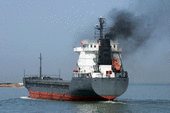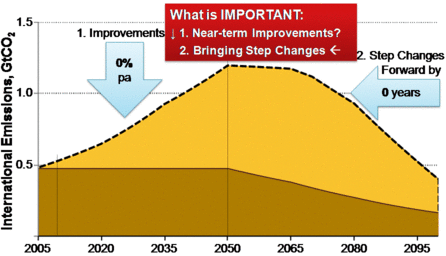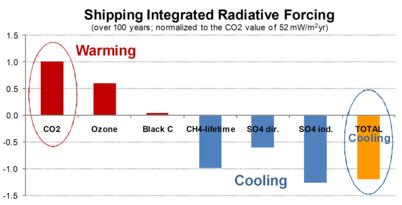Mitigation*2
Maritime Technology Fund or similar is needed
 Both near-term and long-term emission reductions are especially needed in maritime transport due to long lifetime of ships and their engines (symbolized by the mitigation*2 title).
Both near-term and long-term emission reductions are especially needed in maritime transport due to long lifetime of ships and their engines (symbolized by the mitigation*2 title).
Significant total emission reductions will only come with deployment of technology breakthroughs/transformations, such as hydrogen transport. At the same time investment in maritime Research & Design has been declining in recent years.
Investing in bringing forward transformations has major benefits
Simulations clearly show the great importance of bringing forward the step changes called for by IMERS, as animated below (after about 3 seconds).

Cooling effect of shipping
Additional Note: Cooling Effect of Shipping (case for action)
[We prefer to discuss the cooling effect head on rather than leave it aside ...]
Cooling is exerted through reduced methane (CH4) lifetime and atmospheric aerosols effects and has been recently quantified. The most comprehensive study on Climate forcing from the transport sectors has been published by Jan Fuglestvedt, Terje Berntsen, Gunnar Myhre, Kristin Rypdal, and Ragnhild Bieltvedt Skeie (Norway, CICERO Institute) in the respected Proceedings of the National Academy of Sciences of the USA (PNAS; as an open access article). A summary is available at CICERO.
To illustrate the effect for shipping a graph depicting an integrated radiative forcing is shown, as per data kindly provided by the authors. The radiative forcing is integrated over 100 years to fully take into account the long warming impact of CO2 (as per the IPCC recommendations). The impacts are shown for CO2, ozone (O3), black carbon (soot; BC), reduced methane lifetime, and sulphate (CH4). CO2, Ozone and Black carbon have warming effect (shown in red). Reduction of CH4-lifetime, SO4 direct and indirect impacts have cooling effect (in blue). The overall, integrated effect from shipping is of cooling.
Cooling effect of shipping
To further clarify, the integration over 100 years took into account the significantly different lifetimes of different gases. Integrating over a shorter period would increase the cooling value. The impacts are driven by emissions of CO2, NOx, SO2, CO, Voluntary Organic Compounds (VOC), BC and organic carbon (OC) and complex atmospheric processes. Excluded from the graph are very small values for emissions of CH4, N20 and OC.
Cooling effect cannot be used to advocate inaction by shipping
The science behind the radiative forcing is complex and uncertainties regarding the direct and indirect aerosols effect are largest for shipping. Also, NOx and SOx have other impacts that damage environment, especially locally.
Instead of delaying any decisions, a flexibility is needed that would allow to reduce CO2 emissions where it is cheapest and makes the biggest impact. If hard and significant GHG emission reductions were somehow enforced on shipping a double whammy might follow.